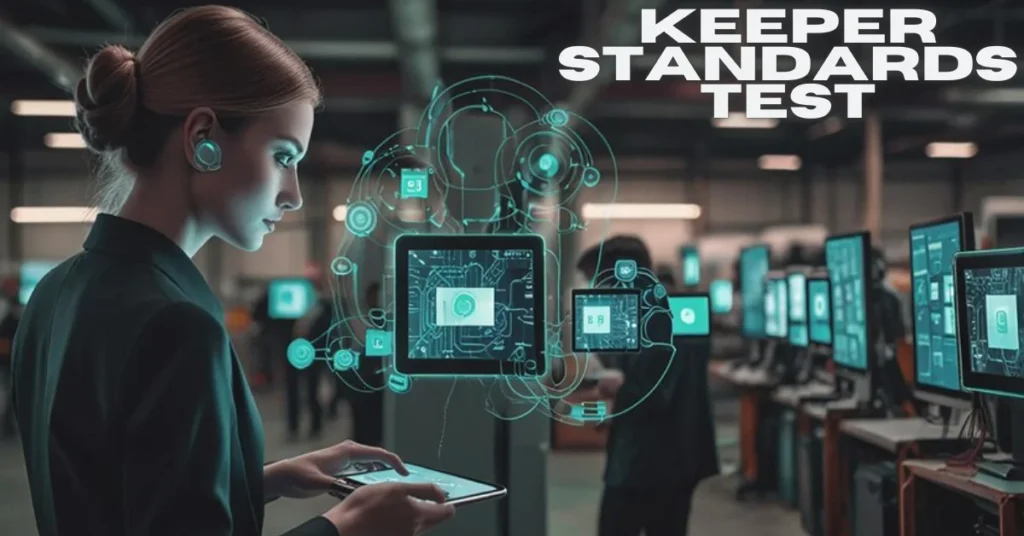Introduction to the need for quality control in AI
In today’s fast-paced digital landscape, the role of artificial intelligence (AI) has expanded dramatically. keeper standards test From healthcare to finance and beyond, AI systems are revolutionizing industries by optimizing processes and enhancing decision-making. However, with these advancements comes a pressing need for quality control. As we increasingly rely on AI-driven solutions, ensuring their reliability and accuracy becomes paramount.
Enter the Keeper Standards Test—a groundbreaking approach designed to maintain high-quality standards in AI applications. This test serves as a pivotal framework that helps organizations assess the effectiveness of their AI systems while mitigating risks associated with errors or biases. In an era where faulty algorithms can have far-reaching consequences, understanding how this test works is essential for businesses aiming to thrive in an automated world. Let’s dive into what makes the Keeper Standards Test so vital for achieving excellence in AI-driven environments.
ALSO READ: Revolutionizing Human-Computer Interaction with Humanilex
What is the Keeper Standards Test?
The Keeper Standards Test is a pivotal framework designed to enhance the integrity of AI-driven systems. It serves as a benchmark for assessing the quality and reliability of artificial intelligence outputs.
At its core, this test evaluates various dimensions such as accuracy, efficiency, and ethical considerations. By establishing clear criteria, organizations can ensure their AI solutions meet industry standards.
Developed through collaborative efforts among experts in technology and ethics, the Keeper Standards Test reflects best practices in AI development. It provides guidelines that are easy to implement while maintaining rigorous assessments.
This test empowers businesses to identify potential pitfalls early in their processes. As a result, they can make informed decisions that align with both operational goals and consumer expectations. Embracing these standards fosters trust between companies and users alike.
The importance of setting standards in AI-driven processes
Setting standards in AI-driven processes is essential for ensuring consistency and reliability. Without clear benchmarks, the technology can produce unpredictable outcomes that may compromise quality.
Standards act as a guiding framework. They help developers create algorithms that perform effectively across various scenarios. This uniformity enhances user trust in AI applications.
Moreover, established standards facilitate collaboration among teams. When everyone adheres to the same guidelines, communication becomes smoother and projects progress more efficiently.
Regulatory compliance is another significant aspect. Setting industry-specific standards ensures adherence to legal requirements, protecting both businesses and consumers from potential risks associated with poorly functioning AI systems.
Strong standards drive innovation by providing a solid foundation on which new technologies can evolve safely and responsibly in diverse industries.
How the Keeper Standards Test works
The Keeper Standards Test operates through a structured framework designed to evaluate AI systems rigorously. It begins by establishing clear performance benchmarks tailored to specific tasks and industries.
Next, the test assesses various aspects of the AI’s functionality. This includes accuracy, reliability, and ethical considerations. Each criterion is meticulously measured against predetermined standards.
Data collection plays a crucial role in this process. Diverse datasets are utilized to ensure comprehensive evaluation under varying conditions. This diversity helps identify potential weaknesses or biases within the AI system.
Once assessments are complete, results are analyzed by experts who provide actionable insights for improvement. Feedback loops encourage continuous refinement of algorithms based on real-world applications.
This systematic approach fosters transparency and accountability while enhancing overall quality control in AI-driven processes. As such, it becomes an essential tool for businesses aiming for excellence in their tech solutions.
Case studies of successful implementation of the test
One notable case study comes from a leading automotive manufacturer. They integrated the Keeper Standards Test to evaluate their AI-driven quality assurance system for assembly lines. By establishing rigorous benchmarks, they reduced defects by 30% within six months.
In another instance, a fintech startup utilized the test to refine its algorithm for fraud detection. Post-implementation analysis showed a remarkable improvement in accuracy rates, boosting user trust and increasing client retention.
A healthcare provider also adopted this approach for patient data management. Applying the Keeper Standards Test enabled them to streamline processes, significantly enhancing compliance with regulatory standards while ensuring data integrity.
These examples highlight how diverse industries can benefit immensely from standardized testing in AI systems. The adaptability of the Keeper Standards Test makes it a powerful tool across various sectors aiming for excellence in quality control.
Common challenges and solutions with implementing the test
Implementing the Keeper Standards Test isn’t without its hurdles. One major challenge is resistance to change within organizations. Many teams are accustomed to their existing workflows and may hesitate to adopt new standards.
Training staff on the test’s principles can also prove daunting. To combat this, companies should invest in comprehensive training programs that emphasize the benefits of high-quality AI output.
Another issue lies in data variability. Different datasets can yield inconsistent results when applying the test. Establishing clear guidelines for data selection and preprocessing helps mitigate these inconsistencies.
Integration with current systems can present technical difficulties. Collaborating closely with IT departments ensures seamless implementation of quality control measures across platforms.
Addressing these challenges head-on paves the way for more effective use of AI technologies in various industries.
Future implications and advancements for AI quality control
The future of AI quality control is poised for transformative changes. As technology advances, the Keeper Standards Test will likely evolve to incorporate more sophisticated algorithms and machine learning techniques. This evolution could enhance accuracy in performance assessments.
Moreover, integrating real-time feedback mechanisms may become standard practice. This would allow AI systems to adapt dynamically based on ongoing evaluations, ensuring continuous improvement.
Collaboration between industry stakeholders can also drive innovation. Sharing best practices and data insights across sectors will foster a collective approach to quality standards.
As regulatory frameworks develop, compliance with these standards can bolster consumer trust. A commitment to high-quality outputs from AI systems might soon be expected rather than optional.
As we push boundaries in AI capabilities, so too must our strategies for maintaining quality assurance expand. The Keeper Standards Test is set to play an essential role in this journey forward.
Conclusion: Why the Keeper Standards Test is crucial for AI-driven industries
The Keeper Standards Test plays a pivotal role in the evolving landscape of AI-driven industries. As artificial intelligence continues to integrate into various sectors, ensuring quality control becomes paramount. This test not only establishes benchmarks for performance and reliability but also fosters trust among users and stakeholders alike.
By implementing the Keeper Standards Test, organizations can mitigate risks associated with AI errors and biases. It empowers teams to maintain high standards while navigating complex algorithms and data sets. The ability to verify that an AI system meets specific criteria enhances accountability, making it easier for businesses to comply with regulations.
Adopting this testing framework signals a commitment to excellence in technology deployment. Companies leveraging the Keeper Standards Test’s are better positioned for long-term success as they innovate responsibly within their fields.
As we delve further into this digital age, prioritizing quality control through rigorous testing like the Keeper Standards Test’s will be essential in harnessing AI’s full potential across industries. Embracing these standards ensures that advancements benefit everyone involved—developers, consumers, and society at large.
FAQs
What is the Keeper Standards Test’s?
The Keeper Standards Test’s is a framework designed to evaluate and ensure the quality and reliability of AI systems. It assesses performance, accuracy, and ethical considerations in AI-driven processes, helping businesses meet industry standards and reduce risks.
Why is quality control important in AI systems?
Quality control in AI systems ensures consistent, accurate, and reliable performance. It reduces the likelihood of errors, biases, or faulty outcomes, which are crucial for maintaining trust and compliance in AI-driven industries.
How does the Keeper Standards Test’s work?
The Keeper Standards Test’s sets specific benchmarks for AI performance. It evaluates accuracy, reliability, and ethical factors using diverse datasets and provides actionable feedback to improve AI systems, ensuring continuous refinement.
What industries benefit from the Keeper Standards Test’s?
Industries such as healthcare, finance, manufacturing, and automotive benefit from the Keeper Standards Test’s. It helps improve AI-driven processes, reduce errors, and ensure compliance with regulatory standards across various sectors.
What are the common challenges in implementing the Keeper Standards Test’s?
Challenges include resistance to change, inconsistent data results, and technical integration difficulties. These can be addressed through comprehensive training, clear data guidelines, and close collaboration with IT departments.







